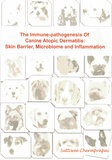The Immune-pathogenesis of Canine Atopic Dermatitis
Skin barrier, Microbiome and Inflammation
Summary
The overall aim of the research was to contribute to further elucidation of the immune-pathogenesis of atopic dermatitis (AD) in the dog. Findings described in this PhD thesis indicated putative alterations occurring in, or inherent to the AD skin. The altered lipid composition and organization observed in both lesional and non-lesional AD skin in dogs, may support the “outside-in” hypothesis, that states that abnormalities in the skin barrier may contribute to the pathogenesis of AD. Alternatively, potentially in addition, the pathogenesis of AD is immunologically driven initially, as postulated by the “inside-out” hypothesis. The microbiome of canine skin varied between individuals and was influenced by the topical antimicrobial treatment. In general, significant differences in the microbiome composition were not observed, between AD and healthy dog skin, although the microbial diversity tended to be lower in affected compared to healthy skin. The microbiome and AD are likely to influence each other. The inflammatory state of the AD skin, partly due to infection, results in expression of both antimicrobial peptides (AMP) and further cytokines, likely to be influenced by anatomical sites and topical treatment. Distortions of the skin homeostasis may lead to significant changes in skin barrier lipid, skin microbiome, AMP and inflammatory cytokines as shown in this thesis. Study of each of these subjects not only led to a more comprehensive understanding of canine AD, but may in future contribute to design of diagnostic and therapeutic strategies.
